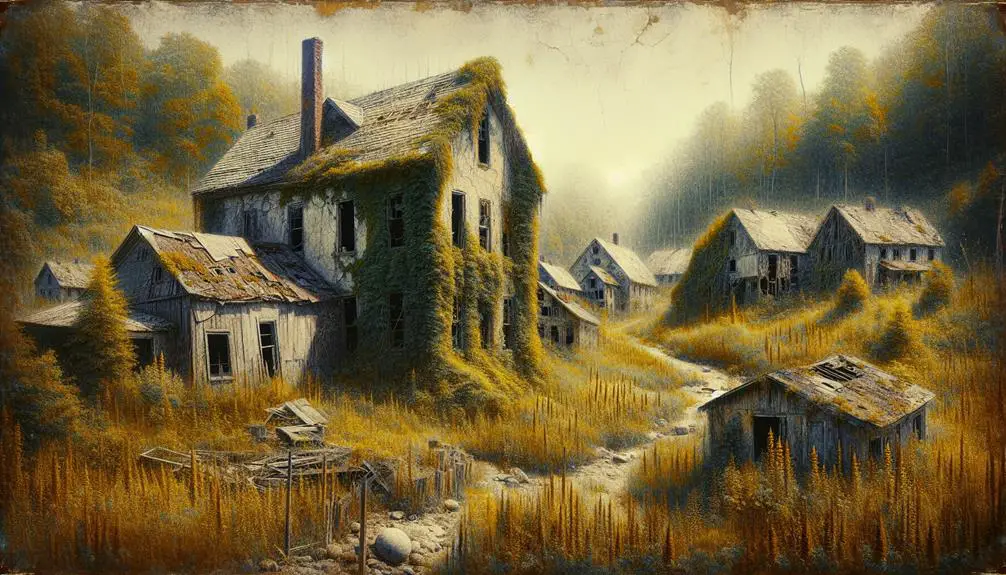Unearth forgotten treasures of abandoned utopian communities in America where dreams mingled with human complexities. Discover Shaker Village's communal living from the 18th century in New England. Explore the rise and fall of New Harmony, a hub of intellects and artists. Utopia, Ohio stands as a cautionary tale of communal living's challenges. Amana Colonies in Iowa offer historical charm and traditions. Baffling Brook Farm reveals the struggles of a transcendentalist utopia. The buried legacies of these communities echo with tales of idealism, conflict, and resilience, waiting for you to uncover more about America's lost treasures.
Key Points
- Shaker Village: A forgotten dream embracing communal living and simplicity.
- New Harmony: Legacy in education, attracted intellectuals, but eventually declined.
- Utopia, Ohio: Founded on communal living, faced conflicts, and cautionary tale.
- Amana Colonies: Preserves German settlers' heritage, community lifestyle in Iowa.
- Brook Farm: Symbol of transcendentalist ideals, financial difficulties, and labor challenges.
Shaker Village: A Forgotten Dream
Nestled in the rolling hills of New England, Shaker Village stands as a poignant reminder of a once-vibrant community now lost to time. Founded in the 18th century, the Shakers sought to create a utopian society based on principles of communal living, simplicity, and equality. Their forgotten legacy echoes through the empty buildings and overgrown fields, speaking of a dream that was once alive with hope and purpose.
Communal living was at the core of the Shaker way of life. Believing in the importance of sharing resources and labor, they lived together in large, gender-segregated communities where all members worked towards common goals. This shared responsibility created a sense of unity and belonging among the Shakers, fostering a strong community bond that sustained them through challenges and triumphs.
Despite their dedication to communal living, the Shakers' numbers dwindled over the years, and today, only a few members remain. The heritage of Shaker Village serves as a bittersweet reminder of a forgotten dream, a validation to the complexities and eventual decline of utopian aspirations.
The Rise and Fall of New Harmony
The history of New Harmony reveals a compelling narrative of idealism, experimentation, and eventual disillusionment within a utopian community setting. Founded in 1814 by industrialist Robert Owen, New Harmony aimed to create a society based on communal living, equality, and education. This social experiment attracted intellectuals, scientists, and artists, drawn by its idealistic vision of harmony and progress.
Initially, New Harmony thrived as a hub of innovation and collaboration. However, internal conflicts, financial troubles, and differing ideologies led to its downfall. The failed experiment highlighted the challenges of sustaining a utopian community in the face of human nature and practical limitations.
Despite its eventual demise, New Harmony left a lasting legacy in the fields of education, social reform, and communal living. The rise and fall of New Harmony serve as a poignant reminder of the complexities involved in realizing utopian aspirations and the delicate balance required to maintain such idealistic visions.
Utopia, Ohio: A Faded Vision
Utopia, Ohio, once envisioned as a harmonious community, now stands as proof of the challenges faced by utopian ideals in practice. Founded in the early 1840s under the principles of communal living, Utopia represented faded hopes of creating a society based on equality and cooperation. Despite the initial enthusiasm that drew settlers seeking a better way of life, internal conflicts and external pressures ultimately led to the community's dissolution.
Within the idyllic landscape of Ohio, residents of Utopia attempted to establish a collective where resources were shared, and decisions made for the common good. However, the reality of sustaining such a system proved more arduous than anticipated. As time passed, disagreements over governance, labor distribution, and individual freedoms eroded the community's unity. The experiment in communal living at Utopia serves as a cautionary tale, highlighting the complexities inherent in transforming utopian visions into sustainable realities.
Through its faded vision, Utopia, Ohio, stands as a reminder of the delicate balance required to uphold ideals of harmony and cooperation in a free society.
Exploring Amana Colonies Today
Located in Iowa, the Amana Colonies offer a glimpse into a historical communal society that has evolved over time. Established in the mid-19th century by German settlers seeking religious freedom, the Amana Colonies showcase a unique blend of historical confirmation and community lifestyle. Today, visitors can explore this living piece of history, where the seven villages that make up the colonies retain much of their original charm and traditions.
The Amana Colonies serve as a confirmation to the resilience of communal living practices and the importance of preserving cultural heritage. Through guided tours and interactive exhibits, visitors can learn about the daily life of the settlers, their craftsmanship, and the values that shaped their community. The commitment to historic preservation is evident in the well-maintained buildings, traditional cuisine, and artisan shops that celebrate the Amana heritage.
The Mystery of Brook Farm
Exploring the historical landscape of communal societies, particularly in the context of Amana Colonies, sheds light on the intriguing enigma surrounding Brook Farm. Founded in the 1840s by transcendentalist ideals, Brook Farm aimed to create a harmonious community where individuals could investigate and uncover the mysteries of intellectual and spiritual growth. The allure of communal living, coupled with the promise of a utopian society, drew in intellectuals, writers, and idealists seeking a new way of life.
However, the reality of sustaining such a community proved challenging. Financial difficulties, differing ideologies, and the demanding physical labor required for farming led to the eventual unraveling of Brook Farm. Despite its short existence, the legacy of Brook Farm endures as a symbol of the complexities inherent in communal living experiments.
The mystery of Brook Farm lies in its rapid rise and fall, leaving behind a legacy that continues to captivate historians and enthusiasts of communal societies. As you investigate the history of Brook Farm, you uncover a narrative that intertwines idealism, struggle, and the enduring quest for a better way of living.
Frequently Asked Questions
What Were the Main Reasons for the Decline and Abandonment of These Utopian Communities?
You ponder the reasons for the decline of utopian communities, seeking understanding in their lack of sustainability. Visionary dreams clashed with practical realities, leading to discord and eventual abandonment, a poignant reminder of the delicate balance between idealism and feasibility.
How Did the Residents of These Communities Sustain Themselves Economically?
To sustain themselves economically, residents of utopian communities engaged in a barter economy, trading goods and services within the community. Communal farming was a key practice, allowing for shared resources and self-sufficiency in food production.
What Kind of Social Structure Did These Communities Have in Place and How Did It Affect Daily Life?
In these communities, social dynamics shaped daily life. A structured hierarchy influenced community interactions. Residents adhered to shared values and norms, fostering a sense of unity. This social structure impacted decision-making and promoted cooperation among members.
Were There Any Notable Conflicts or Controversies Within These Communities That Led to Their Downfall?
Conflicts and controversies within these communities often revolved around ideological differences, internal power struggles, and challenges with economic sustainability. These issues, coupled with a lack of external support, ultimately led to their downfall.
What Legacy, if Any, Do These Abandoned Utopian Communities Leave Behind in Modern Society?
In modern society, the legacy of abandoned utopian communities endures through their impact on cultural trends and social movements. Their influence, though faded, still lingers in the collective consciousness, sparking reflections on idealism and communal living.



